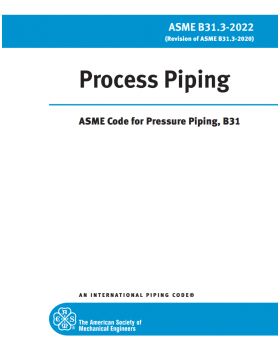NOTE: Our store provide PDF immediately download,To ensure that you can download normally, please complete user registration first,If you choosed the Guest Checkout,we will send the document to you email box immediately.
ASME B31.3-2022
STANDARD by ASME International, 01/30/2023
Format: PDF
ASME B31.3, 2022 Edition – Process Piping
ASME B31.3 contains requirements for piping typically found in petroleum refineries; chemical, pharmaceutical, textile, paper, semiconductor, and cryogenic plants; and related processing plants and terminals. It covers materials and components, design, fabrication, assembly, erection, examination, inspection, and testing of piping.
This Code applies to piping for all fluids including:
(1) raw, intermediate, and finished chemicals;
(2) petroleum products;
(3) gas, steam, air and water;
(4) fluidized solids;
(5) refrigerants; and
(6) cryogenic fluids.
Also included is piping that interconnects pieces or stages within a packaged equipment assembly.
Key changes to this revision include:
Owner
Added specific permission for the owner to designate a representative to carry out selected
responsibilities required by this Code, and noted that the owner retains ultimate responsibility for the actions of the representatives.
Flange Design
Added the ASME BPV Code Section VIII, Division 2, para. 4.16 flange calculation method as an acceptable way to design flanges for B31.3 applications. The Division 2 procedure considers pressure, gasket seating, and externally applied axial forces and net-section bending moments.
Stress Intensification and Flexibility Factors
Added specific references to ASME B31J-2017 as a resource for stress intensification and flexibility factors as an alternate to Appendix D.
High Cycle Fatigue
Added Appendix W, which describes an alternate method for evaluating high cycle fatigue when specified by the owner. The method in intended to be used when the number of significant stress cycles exceed 100,000.
A significant stress cycle is defined as a cycle with a computed stress range greater than 20.7 MPa (3.0 ksi) for ferritic and austenitic steels. For other materials. or corrosive environments, all cycles shall be considered significant unless otherwise documented in the engineering design. The existing rules provide an acceptable method of evaluating piping systems for fatigue when the number of significant stress cycles is less than or equal to 100,000. The piping cyclic loadings may be due to thermal expansion, anchor motion, vibration, inertial loads, wave motion or other sources.
Heat Treatment for Attachment Welds
Added explicit language requiring heat treatment for structural attachments welded directly to pressure-containing materials when the piping is required to be heat treated.
Visual Examination
Added a definition for readily-accessible: those surfaces that can be examined from not more than 600 mm (24 in.) and at an angle not less than 30 degrees to the surface to be examined.
Increased visual examination required for normal fluid service welds from 5% random to 100%.
High Pressure Piping Fatigue Analysis
A fatigue analysis is required for all piping systems in Chapter IX High Pressure Fluid Service. In previous editions, this analysis was permitted to be performed in accordance with the BPV Code, Section VIII, Division 2 or Division 3. Division 2’s fatigue analysis involves using a standard S/N curve to determine the design fatigue life. Division 3 also allows an S/N curve approach, but only if it can be shown that the piping component will fail in a leak-before-burst mode. Otherwise, a more rigorous fracture mechanics evaluation is required. The Division 3 S/N analysis contains several requirements that are not included in Division 2, such as surface finish and mean stress corrections.. Because the Division 2 approach is less precise than the Division 3 approach, wherever possible, Division 2 was eliminated as an option for the required Chapter IX fatigue analysis.
ASME B31.3 is one of ASME’s most requested codes. It serves as a companion to ASME B31.1 Code on Power Piping as well as to the other codes in ASME’s B31 series. Together, they remain essential references for anyone engaged with piping.
Product Details
Revision: 2022 Edition, 2022
Published Date: January 2022
Status: Active, Most Current
Document Language: English
Published By: ASME International (ASME)
Page Count: 584


